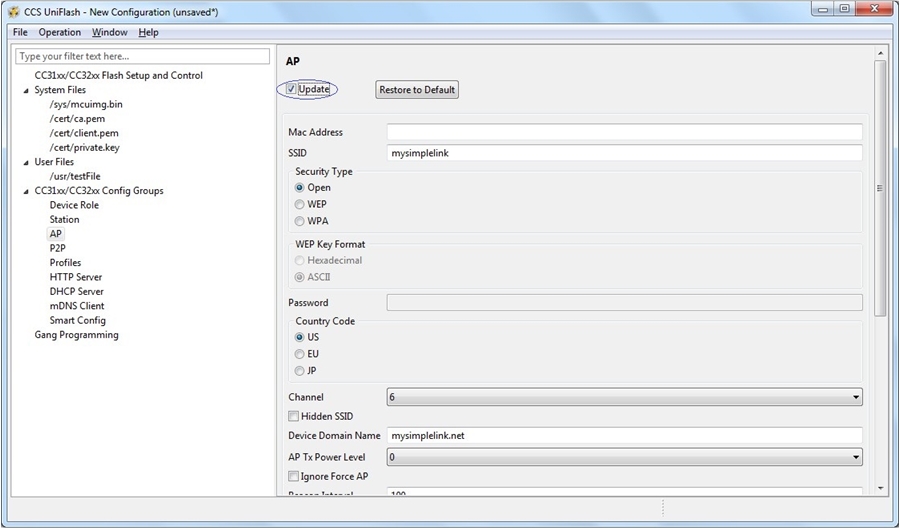SWRU558 June 2020 CC3100 , CC3100MOD , CC3200 , CC3200MOD
-
SimpleLink Wi-Fi CC3100, CC3200 UniFlash
- Trademarks
- 1 Introduction
- 2 Installation
- 3 Prerequisites
- 4 Uniflash Block Diagram
- 5 Session Support
- 6 Secured File System Support
- 7 GUI Interface
- 8 CC3200 Support
- 9 Command Line Support
- 10 Configuration File Support
- 11 Image Creation and Programming
- 12 Troubleshoot/Debugging
- 13 Limitations
- 14 References
- A UART Connection
10.3.3.5 Configuration
Figure 19 shows a screenshot of all the Station parameters. Most parameters have default values in case the user decides to skip configuration. Mac Address parameter is the only one that does not have any default. Not setting this parameter is valid. If not set, the device burnt MAC address is used. In this screen, the following parameters are defined:
- MacAddress is not set. Default MAC address is the already burnt MAC address.
- SSID is set to default mysimplelink
- Security Type is set to default Open
- Password is not relevant since Security Type is set to Open
- WEP Key Format is set to default ASCII
- Country Code is set to default US
- Channel is set to default, channel # 6
- Hidden SSID is set to default Disable
- Device domain Name is set to default mysimplelink.net
- AP Tx Power Level is set to default 0 (transmit at maximum power)
- Ignore Force AP is set to default Disable
- Beacon Interval is set to default 100 TU
- DTIM Interval is set to default 2 BI
- Ap Addressing Scheme is set to default Dynamic (retrieve network parameters from DHCP server)
- Ap IP Address is set to default 192.168.1.1
- Ap Subnet Mask is set to default 255.255.255.0
- Ap Default Gateway is set to default 192.168.1.1
- Ap Default Gateway is set to default 192.168.1.1.
- Ap Network Application is set to default where HTTP Server, DHCP Server and mDNS Client application are enabled.
 Figure 19. Ap Configuration
Figure 19. Ap Configuration